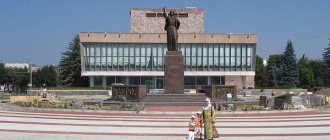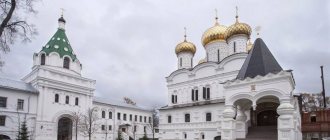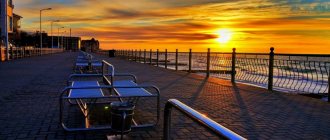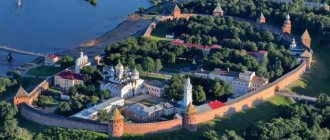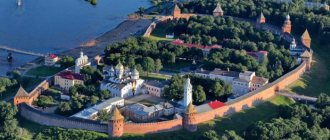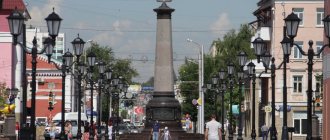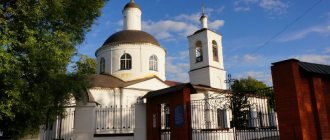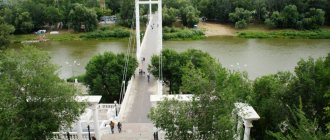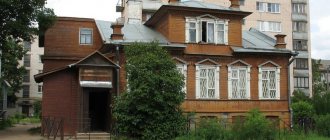Our regular author Anastasia lived in Crimea for a long time and traveled it far and wide. For our website she wrote a guide to the most interesting places in Koktebel.
Koktebel is a small picturesque town located in the southeast of Crimea, near the Koktebel Bay. The town has a very romantic name: from Crimean Tatar it is translated as “the edge of blue hills.” PGT is the canonical representative of the resort town.
Historians do not know the exact date of the founding of Koktebel, but there is an assumption that a tribe of Cimmerians lived here about 2 thousand years ago. It is known that for a long time the village was an ordinary village by the sea, where people lived in modest houses, ate food grown with their own hands, fish caught in the sea and were generally cut off from the outside world.
For those who are going to Koktebel with children, here is a useful story from a mother about the features of a family holiday at this resort.
In the 80s of the 18th century, the Koktebel lands were bought for a pittance by St. Petersburg professor Eduard Junge, who planted a large vineyard in Koktebel and started agriculture. After the death of the professor, the land passed to his sons, who began selling summer cottages in the town. Since at that time Koktebel was still a little-known place, land was not bought very willingly.
However, by the nineties, the village became more popular: famous poets, artists, and scientists often visited it. In 1893, the famous literary figure Maximilian Voloshin settled in Koktebel.
Not far from Koktebel there are a couple of interesting places worth visiting - Sudak is 30 kilometers away - this is the Genoese fortress, the Golitsyn trail and picturesque capes, and Feodosia is 20 kilometers away with its museums and parks.
For ease of route planning, we have marked all the mentioned attractions on the city map:
The main attractions of Koktebel
Koktebel itself, Mount Kara-Dag, bays and beaches, rocks in the sea and the amazing nature of the surrounding area are attractions. The spirit of Maximilian Voloshin, the Guardian Angel of Koktebel, the Teacher, who for decades received, guided, and advised almost all the great and famous poets, writers and artists of the 20th century in his home, is invisibly present here.
The grave of M. Voloshin, which is located on the top of Mount Kuchuk-Yenishary, is still visited by numerous admirers of his talent and the talents of his friends and students.
For vacationers in Koktebel, there are several places that both children and adults willingly visit: a dolphinarium, a water park, and a gliding center on Mount Klementyev.
But besides these close and accessible places, there are many interesting things in Koktebel and its surroundings, which even regulars of this resort often do not know about.
Where to go in the area
There are also more than enough options here: Cape Chameleon and Kara-Dag volcano. Book a boat trip to the Golden Gate or enjoy the joy of swimming on the wild beach in Fox Bay. Some tourists do not recommend taking children there, due to the specific nature of the beach. But it seems to me that it all depends on your family values. To save as much time and effort as possible on the train, I recommend getting a card in advance. By the way, since you are going to the vicinity of Koktebel anyway, I recommend stopping by the village of Ordzhonikidze.
Karadag Reserve
Kara-Dag has been accessible to vacationers for many decades.
They were attracted here by the magnificent views, gems that could be found on the slopes of the mountain back in the 70s, as well as the opportunity to get to inaccessible beaches at the foot of the mountain.
But the flow of people wishing to walk along the mountain was so great that there was a real threat to the existence of the unique nature of Kara-Dag and neighboring mountain ranges. Therefore, in 1979 it was decided to create the Karadag Nature Reserve.
The fauna of the reserve is unique and has not yet been fully studied. 32 species of mammals, 236 species of birds, and 1,700 species of butterflies live here. Among the plants there are many endemics included in the Red Book and in the lists of such organizations as the European Red List, the list of the Bonn Conference.
The organization of the reserve and the ban on mass and uncontrolled walks had a beneficial effect on the nature of this amazing place.
But for true nature lovers, you can visit the reserve. Excursions are conducted here, accompanied by reserve staff, who will tell you in detail about the unique plants and animals of this wonderful place.
The symbol of the reserve is the famous Golden Gate, since its territory includes part of the sea at the foot of the Kara-Dag.
Arch "Golden Gate"
The rock formation in the Black Sea has long been considered a kind of calling card not only of Koktebel, but of the entire Crimea. The arch is located in the waters of the Kara-Dag massif. There are many stories and legends around this place. It is believed that if you swim under the gate, you will have good luck throughout your life. Perhaps that is why there are so many boats, pleasure boats and so on around.
I recommend: a boat trip from Feodosia to Kara-Dag on the ship Mikhail Svetlov.
Koktebelky Hollywood
Back in Soviet times, there was a film studio in Yalta, where more than 1,000 films were shot during its existence.
It is surprising that Koktebel became the most popular filming location, and films from a wide variety of climate zones and countries were shot here. Many of these films became the golden fund of Soviet cinema. Tourists who often vacation in Koktebel recognize familiar landscapes in the frames of their favorite paintings.
It is difficult to understand how it was possible to shoot such different films on Koktebel nature as: “Scarlet Sails”, “The Headless Horseman”, “The Diamond Arm”, “Don Quixote”, “The Lady with the Dog”, “White Sun of the Desert”, “ Master of Chukotka." It’s clear where the sea is in the film, but Spain and the snows of Chukotka! They are where they were “mined” in the southern bays.
Dolphinarium
Dolphinarium in Koktebel
Not far from the water park there is another popular place for family leisure - entertainment and recreation. Experienced instructors skillfully handle animals. Additional services are provided on site, such as dolphin therapy, swimming, bathing, and so on. The pools are huge, the stands are comfortable. A trip here with children will bring an incredible and most positive experience.
- Morskaya st., 77, town Koktebel
- koktebel-delfin.com
On this topic:
Dolphinariums of Crimea
Lake Barakol
Not far from Koktebel there is an unusual and mysterious Lake Barakol.
You can get there by bus going to the village of Kurortny. The journey takes about half an hour. Barakol is a salt lake, which is located at the foot of Mount Klimentyev, in an endorheic valley.
The lake is shallow and, as a rule, dries up in the summer, turning into salt marshes overgrown with reeds, saltwort and saltwort.
This lake is a phenomenon, the solution to which is still unknown today. There are not and never were any rivers or streams in the valley, but the lake has existed for a long time.
Amazing steppe landscapes open onto the lake and the surrounding mountains. They make this short journey worthwhile.
Helpful information
From Simferopol to the resort 120 km. The nearest large settlement is Feodosia (distance – 21 km). Regular buses go from these cities to Koktebel. If you travel from the Crimean capital by car, the journey will take approximately two hours. The village is located directly on the seashore, so it is easy to walk from most guest houses and boarding houses to the beach.
The holiday season officially opens in May and lasts until October. It is better to book places in advance, as there are many vacationers in Koktebel in the summer.
White Mountain – Ak-Kaya
This white vertical rock is visible a kilometer before approaching it.
It rises above the valley of the Biyuk-Karasu River. The symbol of Belogorsk looks like a fortress. White Mountain – that’s what the rock is called – is very old. Over thousands of years, nature has formed bizarre shapes on the surface of the rock. Particularly interesting are the aeolian grottoes formed by the winds.
There are several interesting caves in White Mountain. The lower cave – Bob – is a grotto in the middle of the western wall. Archaeologists discovered traces of Sarmatians in the cave. It is believed that there was a sanctuary here.
Even more interesting is the Upper Cave - Altyn-Teshik - Golden Nora. The entrance to the cave is accessible only to extreme sports enthusiasts; the round entrance to it is located at a height of 52 meters from the ground. Prehistoric man sites have been found in caves.
Excursions are available to White Mountain. The distance of 80 kilometers from Koktebel is worth traveling for stunning views of the mountains in the south and ancient steppe mounds in the north.
Observation deck “Starfall of Memories”
Observation deck “Starfall of Memories”
The site is located at the highest point of the Barakolskaya valley, at an altitude of about 400 meters. The largest influx of tourists to the Starfall of Memories is recorded at the end of summer, in August. The reason is solid: at this time the so-called Perseid meteor shower passes over the planet. And according to legend, if you look at a shooting star from the observation deck and have time to make a wish, your dream will definitely come true.
Read more about Starfall of Memories here
Toplovsky Monastery
People go to Crimea to sunbathe and swim.
Even people who often vacation in Crimea do not often go on excursions, especially deep into the peninsula. Meanwhile, on the ancient peninsula there are many amazing sights that have an interesting, tragic history, in many ways consonant with the history of the country.
29 kilometers from the center of Koktebel, among gardens, forests and mountains, is the village of Topolevka. Not far from the village, on the slopes of Mount Karatau, is the Toplovsky Trinity-Paraskevievsky Convent.
People have settled in this beautiful place in the valley of the Wet Indol River since ancient times. There was a Greek church on this site until the 19th century, the ruins of which can still be seen today.
From the Feodosia-Simferopol highway, the Armenian church located on the top of the hill is still clearly visible. From the 16th to the 18th centuries, Armenians lived here, and the temple was active. In 1778, the Armenians left these places and the temple was abandoned. At the beginning of the 19th century, the ancient temple was restored by the monastery.
Archbishop Innokenty chose the place for the Toplovsky Monastery during his trip to Crimea.
In these places there is a healing spring Chokrak-Saglyk-su - a source of living, healthy water - which was considered holy by both Muslims and Christians. According to ancient legend, Saint Paraskeva, whose name the spring is named after, suffered her last torment at the spring.
Innocent turned to the Synod with a request to found a monastery in the Topolevka tract - as Topolevka was previously called. But plans to found the monastery were interrupted by the Crimean War. But the idea of creating a monastery remained unfulfilled until the 60s of the 19th century.
The Zotov sisters, who owned the Tolpu estate, decided to donate 230 acres of land to the monastery. Fundraising began for the construction of the monastery, in which many people took part.
Construction of the church began in May 1863 and was completed in just 2 months. Things for services were collected from different churches. Bells for the temple were purchased in Simferopol. The temple was consecrated on June 26 by Archbishop Alexy on the day of memory of Saint Paraskeva.
Since the opening of the monastery, it has expanded and received numerous donations and religious relics.
A new temple and hotel, cells for sisters, a hospital, a school for girls were built, an old small temple was restored, and a road to the monastery was laid.
A few years later, the monastery became the owner of many religious religions: the icon of the Kazan Mother of God, which was decorated with a silver and gilded robe, precious stones, particles of the Honorable and Life-Giving Cross of the Lord, particles of the relics of the holy great martyr and healer Panteleimon and the holy venerable martyr Paraskeva.
These shrines attracted a large number of pilgrims, and the monastery flourished. By 1917, 241 nuns lived in the monastery.
During the years of Soviet power, the monastery was plundered many times, and then was completely closed. The second life of the monastery began in 1992.
For more than 20 years, the monastery has been being restored, temples, chapels, and baths over the holy springs are being rebuilt.
Miraculous healings still occur in the monastery today; people come here for services, to receive healing, to pray, to bathe in a holy spring, or simply for a blessing.
You can visit the monastery: from 6:00 to 21:00. Address of the monastery: Crimea, Belogorsky district, village. Educational (Verkhnyaya Topolyovka). Phone: +380-6559-92676.
You can visit the monastery only with a special, pre-booked excursion. The tour is not cheap, but the trip is worth the money spent. The journey will take about two hours.
Temple "Quench My Sorrows"
Church in honor of the icon of the Mother of God
Literally a 5-minute walk from the Koktebel bus station there is a relatively young church, built in 2008 and named in honor of the icon of the Mother of God. At the beginning of the 20th century. a church was already built here and consecrated, but completely destroyed after the Revolution of 1917. Restoration gradually began in the 90s, and was completed only in 2008. Now the temple is operational, services are held in it according to the traditional schedule and accepted in them Anyone can participate.
On a note
! Like most churches, the “Quench My Sorrows” church has a traditional shop where you can buy candles, icons and other ritual items.
Koktebel Factory of Vintage Wines and Cognacs
7 kilometers from the center of Koktebel there is a factory of vintage wines and cognacs.
The Ortuz Valley is an ideal place for growing grapes. Even the ancient Greeks grew grapes here and produced white, red and white wines. In 1879, doctor, academician and one of the founders of Koktebel, Eduard Junge, laid out grape plantations here.
After the revolution, winemaking did not disappear, but even expanded. State farms and artels for wine production were organized. In the 60s of the last century, metro builders carried out unique work to create huge basements near the village of Planerskoye.
The storage facility, called the Second Plant, has no analogues. The eight tunnels, 60 meters long, 8.4 meters wide and 7.6 meters high, have a total length of almost 1.5 kilometers.
The plant produces unique wines and cognacs, the recipes of which have been preserved since the 19th century. At international exhibitions, the plant's products received 122 gold medals, 40 silver medals and many certificates and diplomas from International exhibitions.
The main products are aged from 3 to 15 years, 25-year-old Kutuzov cognac and 30-year-old Macedonian cognac, as well as ordinary wines and vintage wines.
The plant has its own tasting room, open year-round. Address: Koktebel, Lenin street, 83. Phone: +380656224357. Tastings are held upon prior request for groups of at least ten people.
How the village lives
Koktebel is located 20 km from Feodosia and is part of it. This is the eastern coast of the Crimean peninsula. If you want to relax quietly, enjoy quiet and cozy evenings, then this is not the place for you. This resort village is a favorite place not only for young people, but also for married couples. There are always a lot of people here and a lot of entertainment, the infrastructure is well developed.
And for children, Koktebel is simply a paradise, because there is a water park, a dolphinarium, and many other adventures.
Background information: Population: 2955 people; Length: 0.817 km square; Index: 298186
Koktebel has well-developed transport links with neighboring Feodosia; many local residents go there to work every day. There is a shopping center where you can buy clothes, groceries and other necessities. ATMs, Internet cafes, a first-aid post and pharmacies are also available to vacationers.
You can have a delicious meal in any restaurant, canteen and cafe. In the summer season there are simply a huge number of them.
It is customary to hold various rallies and festivals in the village. For example, an international dance festival.
Sunny Valley - Archaderesse
Sunny Valley lives up to its name - there are 300 sunny days a year.
But this valley received this name recently; since ancient times it was called Kozskaya, which translated from the Turkic language means “eyes”. Another name for the valley is “the back of the ravines” - Archaderesse. The first owner of the valley was the first Russian winemaker Lev Sergeevich Golitsin. Here the great winemaker began cultivating grape varieties for making dessert wines.
These wines still exist; they are famous not only in our country, but also abroad. Unique Solnechnaya Dolina wines “Black Doctor”, “Black Colonel” and white wine “Solnechnaya Dolina” can be purchased in the store at the plant.
The descent into the valley begins from the Sudak-Feodosia highway in front of the large rock Porsuk-Kaya. This rock is a coral reef that was once at the bottom of an ancient sea. The Eltigen ridge has three rocks - towers that guard the entrance to the valley.
The tallest tower has a hole through it, which is why the rock got the name “Leaky Rock.” Golitsyn carved out cellars inside this rock. If you climb the rock from the northwest, you can see traces of an ancient road.
In the 18th and 19th centuries, many ruins of fortifications, temples, and cemeteries of ancient times could be seen here.
In order to see the vineyards, you need to go around Pandasha Hill at the end of the village of Solnechnaya Dolina. Behind the hill there are two reservoirs. Grapes grow on flat hills formed by ancient rivers.
From this place you can clearly see the Echki-Dag mountain range, and behind it the Kara-Dag. For lovers of deserted and unfamiliar places, a journey to the top of Chap-Kai through a deep ravine, past the ruins of ancient walls, the “Small Wall” and the “Gate” will leave an unforgettable impression. This is a completely different Crimea, not a beach, not a resort. But very beautiful and unusual.
It’s worth visiting Sunny Valley for the ancient Basilica of St. Elias, which was built in the 9th – 11th centuries. The basilica is located in the very center of the village of Solnechnaya Dolina, on a high hill above the bus stop.
The architecture of Armenian churches served as a model for the construction of the temple. The temple was miraculously preserved, having survived many tragedies that occurred on the ancient peninsula over many centuries.
During the conquest of Crimea, Russian troops defeated the Turkish army in 1771. The Turks who lived in Koza killed the priest Peter of the Church of St. Elijah. The grave of an Orthodox priest is located at the entrance to the temple. Sick people came to the grave asking for healing.
The temple contained an ancient relic - a marble font made from a column of a 4th-5th century pagan temple on the island of Procones in the Sea of Marmara. She was brought to Crimea from Constantinople.
Services in the temple continued until 1936. Then it suffered the fate of most churches in Russia: there was a power plant, a granary, and then the temple was completely abandoned.
Only in 1990 was the temple restored and services resumed. In 2000, the font was found and returned to the temple. Today this amazing monument is available for visiting.
From Koktebel to the village of Solnechnaya Dolina 24 kilometers. The easiest way to get here is by taxi. There is no direct bus.
Another route option: by regular bus to Sudak, from Sudak by bus to Mindalnoe. You need to find out the schedule in advance, buses do not run often.
Cape Chameleon
What you need to watch before it disappears. Intriguing, isn't it? Over the past 70 years, the cape has been hewn by the sea surf and has lost about 35% of its original volume. Who knows when nature will deprive us of such beauty?
Walk along a quaint path to the cliff, where the endless sea touches the sky and the line between a real picture and the feeling that you are seeing in front of you a painting by an unknown but very talented artist is blurred.
Try coming here at sunset. The unreality of the landscapes fascinates and takes your breath away.
Good news for those who love secluded, wild beaches! Not far from the ridge you can swim in splendid solitude and enjoy the majesty of the ridge in a calm environment. The water there is very clean, so when going to Chameleon, be sure to bring a swimsuit.
There are two ways to get to the cape:
- On foot. The journey will take approximately 50 minutes from Koktebel. In cool weather it’s great, but if you are caught by the sultry Crimean sun, don’t expect mercy.
- By car. If you rent a car in Koktebel, the trip will definitely be much more comfortable. The landmark is the eastern road to the village of Ordzhonikidze.
Coordinates of the cape : GPS N 44.962574, E 35.294710.
Of course, it's free.
Cultural events in Koktebel
The jazz festival in Koktebel has been organized every September for 13 years.
Experienced and famous performers usually perform on the chamber stage, and promising musicians from Russia and abroad play on the open stage.
In odd-numbered years, Voloshin readings are held at the Voloshin House-Museum , bringing together writers and scientists from European and Asian countries. Also, this institution annually, on May 28, celebrates the birthday of the artist, poet and founder of Russian naturism, Maximilian Voloshin.
as a venue for air sports competitions since 1923. Now the village hosts 2 festivals annually: “Crimean Aviation Games” and “Air Brotherhood”.
During which participants fly:
- on airplanes;
- balloons;
- hang gliders and paragliders;
- jump with a parachute;
- fly kites.
The location of both events is Mount Klementyeva. The first of them occurs in early May, and the second in September.
Immediately after the victory holiday, on May 10, and in October, cycling festivals are held in the village; riders from all over Russia show their skills in trials, cyclocross, cross-country and other sports disciplines.
In addition, Koktebel hosts the Golden Cue billiards competition , the Tango festival (during the May holidays) and many small artist exhibitions (throughout the summer).
Koktebel is not only one of the best, elite resorts in Crimea, but also an interesting place that preserves monuments of ancient times, unique natural attractions, providing an interesting and varied holiday.
M. Voloshin Museum
Voloshin Museum
In the house of Maximilian Voloshin, the museum was created in 1984, completely recreating all the conditions and environment in which the poet lived. Today, the house of the great poet houses a library, a study and a living room. Collections of gems, dried plants, and sea shells are no less interesting.
- Address: Morskaya st., 43, Koktebel,
- Phones: +7 36562 2‑45-06, +7 36562 2‑44-37
I recommend: take a tour guide. This way you can learn more interesting things about Voloshin’s life and work. About his friends entering the house.
Entertainment
You have already become acquainted with the historical sights of the city of Koktebel, now it’s time to have fun - especially since the small village has everything: beach holidays, shows, educational places for wildlife lovers.
Beaches
All the shores are pebbly, but upon entering the water, you can feel the sandy bottom. Here the beaches differ from each other, there are narrow and wide, developed and wild, as well as nudist. The well-kept seashore of the Santorini hotel is very attractive. And on the one that belongs to the Primorye health complex, marine entertainment is offered:
- pedal boats and motorcycles;
- kayaks, paddleboards, catamarans, dinghies, surfboards;
- sailing yacht;
- ordering a boat, excursions along the coast;
- fishing;
- underwater diving.
Dolphinarium "Koktebel"
This kind of entertainment has been delighting residents and guests of the village since 2008. Bottlenose dolphins, beluga whales and fur seals live here. They have a busy life, like all real artists - rehearsals, performances, and they also take part in research (scientists are very interested in the language of communication of these sea inhabitants).
Performances with these creatures evoke a storm of positive emotions among spectators of any age: trainers create complex performances to demonstrate the developed intelligence of their charges.
Water park "Koktebel"
This water kingdom is the largest and newest park in Crimea. Here you will find:
- 24 slides, 12 of them are for children, 2 are exclusive, for extreme sports enthusiasts.
- Special area for children.
- An aquarium where seahorses, stingrays and piranhas live.
- Petting zoo with monkeys, squirrels, goats and even raccoons.
- Terrarium - snakes, water turtles, and iguanas have settled here.
Here you can also play billiards, ping-pong and air hockey, order an ATV ride, and a grill bar, restaurant and pizzeria await the hungry.
Dinotherium
The ornithological park is ideal for visits with the whole family. A most interesting place, the appearance of which is unusual: as if two huge circles were half buried in the ground. There are located:
- Paleontological pavilion where the ancestor of the bird park “lives”: a model of the skeleton of a prehistoric elephant-like animal (an exact copy of the remains once found in the Karadag region).
- Living Nature Hall. Many birds, turtles, and lizards live here. Bright parrots - macaws, rosellas, aratingas and cockatoos. They are extremely sociable and can easily sit on guests' shoulders.
- The Labyrinth of Time is an unusual attraction where you need to collect “antique” coins in order to see an amazing “artifact” in the end: the Clock of the Universe.

